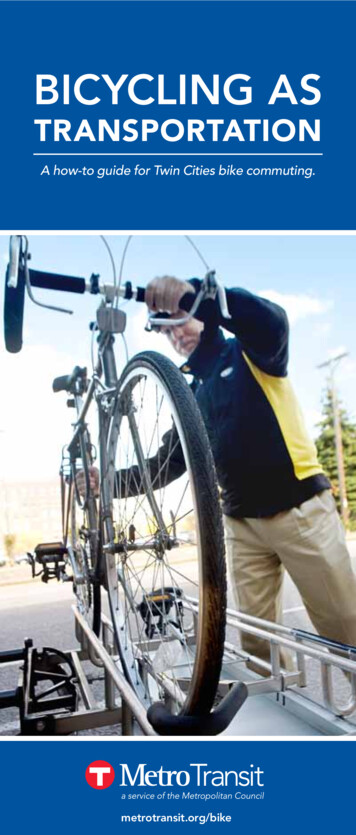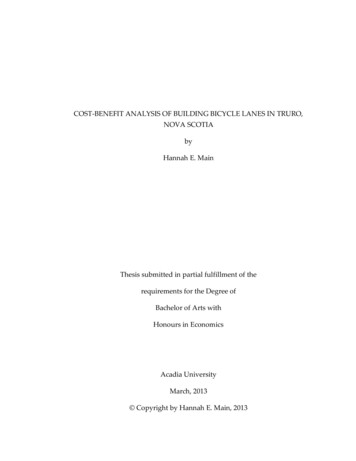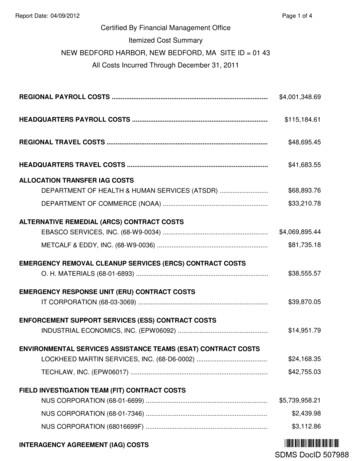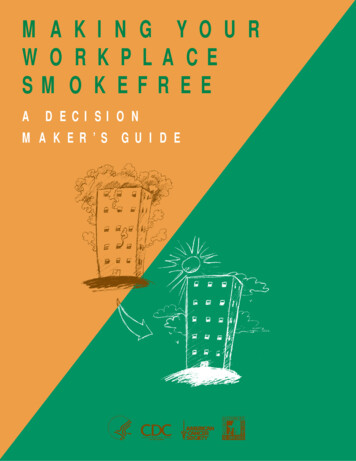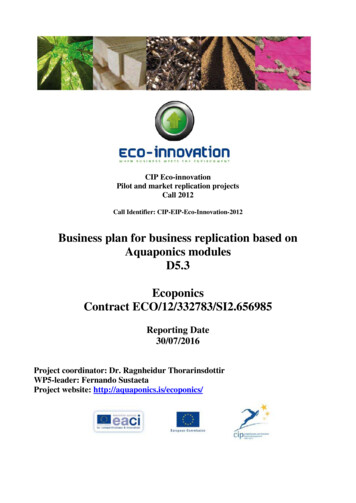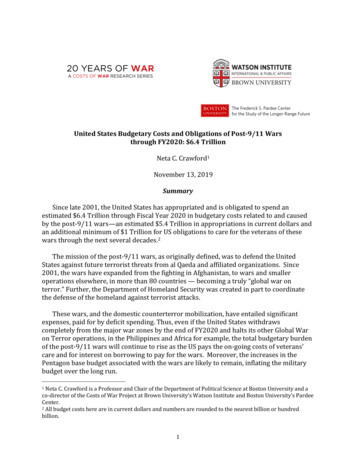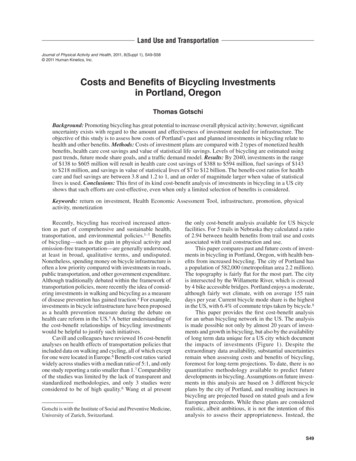
Transcription
Land Use and TransportationJournal of Physical Activity and Health, 2011, 8(Suppl 1), S49-S58 2011 Human Kinetics, Inc.Costs and Benefits of Bicycling Investmentsin Portland, OregonThomas GotschiBackground: Promoting bicycling has great potential to increase overall physical activity; however, significantuncertainty exists with regard to the amount and effectiveness of investment needed for infrastructure. Theobjective of this study is to assess how costs of Portland’s past and planned investments in bicycling relate tohealth and other benefits. Methods: Costs of investment plans are compared with 2 types of monetized healthbenefits, health care cost savings and value of statistical life savings. Levels of bicycling are estimated usingpast trends, future mode share goals, and a traffic demand model. Results: By 2040, investments in the rangeof 138 to 605 million will result in health care cost savings of 388 to 594 million, fuel savings of 143to 218 million, and savings in value of statistical lives of 7 to 12 billion. The benefit-cost ratios for healthcare and fuel savings are between 3.8 and 1.2 to 1, and an order of magnitude larger when value of statisticallives is used. Conclusions: This first of its kind cost-benefit analysis of investments in bicycling in a US cityshows that such efforts are cost-effective, even when only a limited selection of benefits is considered.Keywords: return on investment, Health Economic Assessment Tool, infrastructure, promotion, physicalactivity, monetizationRecently, bicycling has received increased attention as part of comprehensive and sustainable health,transportation, and environmental policies.1–3 Benefitsof bicycling—such as the gain in physical activity andemission-free transportation—are generally understood,at least in broad, qualitative terms, and undisputed.Nonetheless, spending money on bicycle infrastructure isoften a low priority compared with investments in roads,public transportation, and other government expenditure.Although traditionally debated within the framework oftransportation policies, more recently the idea of considering investments in walking and bicycling as a measureof disease prevention has gained traction.4 For example,investments in bicycle infrastructure have been proposedas a health prevention measure during the debate onhealth care reform in the US.5 A better understanding ofthe cost-benefit relationships of bicycling investmentswould be helpful to justify such initiatives.Cavill and colleagues have reviewed 16 cost-benefitanalyses on health effects of transportation policies thatincluded data on walking and cycling, all of which exceptfor one were located in Europe.6 Benefit-cost ratios variedwidely across studies with a median ratio of 5:1, and onlyone study reporting a ratio smaller than 1.7 Comparabilityof the studies was limited by the lack of transparent andstandardized methodologies, and only 3 studies wereconsidered to be of high quality.6 Wang et al presentGotschi is with the Institute of Social and Preventive Medicine,University of Zurich, Switzerland.the only cost-benefit analysis available for US bicyclefacilities. For 5 trails in Nebraska they calculated a ratioof 2.94 between health benefits from trail use and costsassociated with trail construction and use.This paper compares past and future costs of investments in bicycling in Portland, Oregon, with health benefits from increased bicycling. The city of Portland hasa population of 582,000 (metropolitan area 2.2 million).The topography is fairly flat for the most part. The cityis intersected by the Willamette River, which is crossedby 4 bike accessible bridges. Portland enjoys a moderate,although fairly wet climate, with on average 155 raindays per year. Current bicycle mode share is the highestin the US, with 6.4% of commute trips taken by bicycle.8This paper provides the first cost-benefit analysisfor an urban bicycling network in the US. The analysisis made possible not only by almost 20 years of investments and growth in bicycling, but also by the availabilityof long term data unique for a US city which documentthe impacts of investments (Figure 1). Despite theextraordinary data availability, substantial uncertaintiesremain when assessing costs and benefits of bicycling,foremost for long-term projections. To date, there is noquantitative methodology available to predict futuredevelopments in bicycling. Assumptions on future investments in this analysis are based on 3 different bicycleplans by the city of Portland, and resulting increases inbicycling are projected based on stated goals and a fewEuropean precedents. While these plans are consideredrealistic, albeit ambitious, it is not the intention of thisanalysis to assess their appropriateness. Instead, theS49
S50 GotschiFigure 1 — Portland bikeway network development and growth in daily bicycle traffic across 4 bridges over the Willamette Riverfrom 1991 to 2008.analysis evaluates health related economic aspects ofpast and planned developments of bicycling based ona transparently presented set of assumptions. As such,this analysis serves 3 main purposes: 1) presentation ofempirical findings, 2) economic evaluation of existingplanning scenarios, and 3) discussion of methodologicalissues that come with the comparison of investment coststo health benefits of bicycling.MethodsCosts of bicycle investments in the past and under 3future plans are compared with 2 types of monetizedhealth benefits: health care cost savings and reductionin mortality, monetized as value of statistical lives.9 Inaddition, fuel cost savings are assessed. Because the vastmajority of investments fund infrastructure projects withlong life spans, calculations are conducted over a 50-yearperiod from 1991 to 2040.The comparison of costs of investments to resultingbenefits requires a number of steps, several of whichrequire assumptions. Monetary figures reflect 2008values. For future values, a discount rate of 3% is applied,reflecting an estimated long term average rate of UStreasury bonds.10The chain of calculations is sketched out in Figure 2,and includes the following steps: 1) compilation of pastcosts and plans for future investments, 2) extrapolation offuture trends in bicycling based on past counts and goalsfor the future, 3) conversion of bicycle counts to milesbiked, 4) calculation of physical activity from cycling, and5) monetization of health benefits from physical activity.Investment CostsIn 2008, the city of Portland estimated the hypotheticalcost of rebuilding its entire 274-mile bikeway networkat 57 million. In 2003, the city also initiated the SmartTrips program which encourages bicycling, walking, and
Portland Bicycling Cost-Benefit Analysis S51Figure 2 — Conceptual framework of the cost-benefit analysis (not including benefits of fuel savings).use of public transportation, at an estimated cumulativecost through 2012 of 7.2 million.11Estimates for future investments are based on 3 different plans by the city of Portland: a “basic” 100 millionplan proposed in the context of the renewal of the federaltransportation bill due in 2009;12 an “80% plan” over 329 million to put 80% of all residents within a quartermile of a developed, low-stress bikeway, and a “worldclass” plan with a price tag of 773 million. The latter 2plans are part of the recently adopted 2030 bike masterplan for Portland.13 Among others, these plans foreseeinvestments in crucial trail sections, bicycle boulevards(traffic calmed streets which limit motorized throughtraffic and specifically accommodate bicycles), cycletracks (bicycle lanes physically separated from traffic),bicycle and pedestrian bridges, various improvements andmaintenance of existing infrastructure, the continuationof Smart Trips, and several additional projects.User-side costs for bicycle purchase and maintenance, as well as opportunity costs are not included (seeDiscussion).Levels of BicyclingTo estimate benefits of bicycling it is necessary to assessbicycling as total miles traveled, a particular challengesince bicycling is typically measured either throughon-street counts, or as percent of all trips (mode share.)Observed trends can inform expectations for thefuture to some extent, but projections require assumptionson long term levels of bicycling. Based on the past growthin bicycling of 10% annually (see Figure 1) and Portland’sgoal of a 25% future bicycle mode share,12 this analysisassumes bicycle mode shares by 2030 of 15, 20, and 25%,for the basic, 80%, and world class plan, respectively.These mode share goals are roughly equivalent to a 3-,4-, and 5-fold increase in bicycling over current levelsby 2030, respectively. Based on these considerations,50-year bicycle count series were constructed for eachplan, consisting of the observed annual bridge bicyclecounts of 2900 cyclists in 1991 to the 16,700 in 2008, alinear interpolation between 2008 levels and 2030 goals(3, 4, and 5-fold of current levels), and a plateau between2030 and 2040 (see Figure 3.)To convert bridge bicycle counts to miles, Portland’smetropolitan traffic model is used.14 This discrete modechoice model estimates miles bicycled in Portland in2005, based on trip cost, trip time, socioeconomic factors and urban form. The ratio between modeled bicyclemiles and bicycle counts in 2005 is then multiplied withthe interpolated bike count data to derive a projectionof future miles biked (Figure 3.) For this calculationbicycle miles for trips 3 miles or less were used. Longertrips were excluded based on a conservative assumptionthat the type of urban bicycle infrastructure, which is thesubject of this analysis, primarily caters to shorter trips ofutilitarian nature, and that future growth in bicycling willpredominantly occur in the segment of relatively shortroutine trips for transportation, rather than recreationalpurposes.Health BenefitsMiles of bicycling are converted into minutes of physical activity assuming an average speed of 10 mph.15 Tomonetize the benefits from physical activity 2 differentapproaches are used.The first approach assesses savings in health carecosts from achieving a sufficient level of physical activity,based on the recommendation of the Centers for DiseaseControl and Prevention of 30 minutes of moderate physical activity on almost every day.16 Several studies havecompared health care expenditures between active andinactive individuals using various definitions for activity
S52 GotschiFigure 3 — Observed bicycle bridge traffic from1991 to 2008 (diamonds), and observed and projected bicycle mode share (dots)and extrapolated annual miles bicycled (solid lines) for 3 investment plans in Portland from 1991 to 2040.and types of expenditures.17 For this analysis, 3 studieswere considered suited and of sufficient quality to derivean average estimate of health care costs from inactivity,per person.Colditz et al reviewed the scientific literature andestimated that in 1995 in the US, the lack of physicalactivity (defined as absence of leisure time activity)cost 24 billion in treatments of morbidities, such ascoronary heart disease, hypertension, Type II diabetes,colon cancer, depression and anxiety, and osteoporotichip fractures.18Linking 1996 Medical Expenditure Panel Surveyto the 1995 National Health Interview Survey, Wang etal estimate the national health care costs from cardiovascular disease attributable to inactivity to be 23.7billion in 2001.19To estimate the health care cost per inactive person,the total estimates provided by Wang et al and Colditz etal are divided by the total US population of the year ofthe estimate, divided by 0.75 to adjust for the proportionof adults, and divided by 0.48 to adjust for the proportionof inactive people. Although the original studies applydifferent definitions in their calculations, using the samedefinition for the adjustment of prevalence of inactivity(ie, 48%) reduces the variation between these estimatesand leads to more conservative per capita estimates.The resulting per capita health care costs attributable toinactivity are 257 in 1996, based on the study by Colditzet al,18 and 231 in 2001, based on the study by Wanget al.19 The third study by Pratt et al provides direct percapita estimates of 330 in 1987 attributable to inactivity.20 All 3 estimates are inflated to 2008 dollars usingthe consumer price index for medical care (www.bls.gov) with an annual average increase of 4.2% between1991 and 2008. The inflation-adjusted estimates are thenaveraged to derive the final estimate of 544.To apply this dichotomous estimate to physicalactivity from bicycling, the underlying difference inactivity between active and inactive people needs to beknown (measured in minutes). To the best of the author’sknowledge, this information has not been published, andtherefore was derived based on the following assumptions. The studies which estimate costs of inactivity defineit as lack of leisure time activity, not considering othersources of activity, but for lack of better alternatives,types of physical activity are not distinguished for thisanalysis and the current recommendation for physicalactivity levels, namely 30 minutes per day, is used as thecut-off between inactive and active people. People belowthis cut-off are assumed to get on average 15 minutes ofphysical activity a day—clearly not enough to meet the 30minutes cut-off, but also clearly more than no activity atall. People above the cut-off are assumed to get on average45 minutes in physical activity—the vast majority of themsomewhere between 30 and 60 minutes—per day. Underthese assumptions, it takes on average 30 minutes of
Portland Bicycling Cost-Benefit Analysis S53physical activity for an inactive person to become active.Thirty minutes of daily bicycling are therefore creditedwith 544 in health care savings annually.In the second approach the World Health Organization’s Health Economic Assessment Tool (HEAT) forcycling is applied.21 The tool uses a relative risk estimatefor all cause mortality of 0.72 for 3 hours of bicycling towork per week, from a large Danish cohort study, adjustedfor other forms of physical activity.22 Based on input of anannual number of bicycle trips and their average length,the tool calculates the number and value of statisticallives saved due to bicycling. The default parameters areadjusted to the US using a mortality rate of 0.0034 anda statistical value of life of 5.8 million, as suggested bythe US Department of Transportation,9 and to reflect thesettings of this analysis (see online supplements).Fuel SavingsFor the purpose of calculating fuel savings bicycle trips of3 miles or less are assumed to be utilitarian in nature, inother words replacing driving (the substitution of transittrips is assumed to be negligible). Fuel savings are calculated assuming a fuel economy of 20.2 miles per gallonbetween 1991 and 2006, which thereafter increases to 35miles per gallon by 2030. Actual national average fuelprices are used for past years, and average predictions bythe Energy Information Administration (www.eia.gov)are used for future years.ResultsSince 1991, Portland conducts annual counts of cyclistscrossing bridges across the Willamette River. From1991 through 2008 the number increased 5-fold at anexponential rate of 9.6% per year (R2 for exponentialtrend line: 0.96). From 2006 to 2007 and from 2007 to2008 growth was 22% and 14%, respectively (Figure1).23 The same trend is reflected in mode share figures,which increased from 1.8% in 1996% to 6.4% in 2008(American Community Survey).8 (The City of Portlandprovides somewhat higher figures based on its own surveyshowing a 3% mode share in 1997 and a recent spike to8% in 2008.)24This calculation is based on projected 3-, 4-, and5-fold increases in miles bicycled by 2030, under 3 different investment plans, respectively.12,13 The projectionseventually plateau at 86, 116, and 145 million annualmiles in 2030, respectively, as shown in Figure 3. By 2040these will accumulate 2.2, 2.8, and 3.4 billion miles ofbicycling, respectively, attributable to Portland’s investments since 1991.Developments of investment costs, health benefits,and net benefits (including fuel savings) are shown inFigure 4. Results of the analysis are summarized inTable 1.Total values of investments in 2008 dollars of 138, 296, and 605 million are included in the calculationfor the 3 plans, respectively, including 57 million inFigure 4 — Cumulative costs (solid lines), health care savings (dots), and net benefits including fuel savings (triangles) of 3 bicycleinvestment plans in Portland, 1991 to 2040.
S54 GotschiTable 1 Key Figures and Results for 3 Investment Plans for Bicycling in Portland (Dollar Figuresare in Millions of 2008 Dollars)Investment costs (after discounting; incl. past)Projected mode share by 2030Max. annual bike miles (2030–2040)Max. daily bike trips (3km trip length)Cumulative bike miles 1991–2040Cumulative health care savings 1991–2040Cumulative fuel savings 1991–2040Cumulative net benefits 1991–2040Year to break evenAnnual lives saved (1991–2040 average)Annual value of statistical lives saved (1991–2040 average)Cumulative value of statistical lives saved (1991–2040)Benefit-cost ratio for health care fuel savingsBenefit-cost ratio for value of statistical lives savedpast infrastructure investments and 7.2 million in promotional efforts.By 2008, cyclists have accumulated 109 millionmiles over the baseline level of 1991, equivalent to 42million in health care savings and 16 million in fuelsavings, or a net cost of 7.8 million.By 2015, the investment costs and benefits will breakeven for the 2 cheaper plans. For the world class plan thiswill be the case in 2032.By 2040, the miles bicycled for the 3 plans convert toa total of 388, 491, and 594 million in health care costsavings, respectively, as shown in Figure 4. Fuel savingsamount to 143, 180, and 218 million, respectively (notshown.) Adding up health care savings, fuel savings, andinvestment costs, the net benefits will be 394, 375, and 207 million, respectively.The increase in bicycling between 1991 and 2040 isequivalent to an average of approximately 60,000, 80,000,and 100,000 daily trips of 3km in length, for the 3 plansrespectively, which using HEAT results is 42, 55, and 68lives saved per year, respectively.Benefit-cost ratios based on health care and fuelsavings are 3.8, 2.3, and 1.3 for the basic, 80%, andworld class plan, respectively. Using value of statisticallives saved, the benefit-cost ratios are 53, 33, and 20,respectively.Discussion and ConclusionsThe presented analysis shows that investments in bicycling are cost-effective, even for a limited selection ofbenefits. Crucial data, such as bicycle counts and modeledmiles of bicycling, render a cost-benefit analysis for Portland’s bicycle investments feasible, albeit with a numberof uncertainties. Besides assumptions on investment costsBasic80%World Class 13815%86M60,0002200M 388 143 394201542 147 73503.853.3 29620%116M80,0002800M 491 180 375201555 196 98002.333.1 60525%145M100,0003400M 594 218 207203268 245 12,2501.320.2and resulting levels of bicycling, the choice of method toquantify health benefits is particularly influential for thebenefit-cost relationship.The more relevant issues are discussed in the following sections.Estimating Investment CostsBuilding transportation networks is characterized by anonlinear S-shaped return-on-investment curve, whereearly investments yield little, midway investments yieldmaximum, and later investments again yield less returnper invested dollar.25 The assumptions in this analysissuggest that the basic plan will benefit most strongly fromearlier investments that built the base for a functioningnetwork of bicycle facilities, yielding roughly 4 timesthe amount of bicycle miles traveled per invested dollar,compared with past investments. The 80% plan yieldsabout twice as much, and the world class plan about thesame, reflecting that the more expensive plans achievelevels of cycling where attracting even more people tobicycling comes at a steeper price. As such, these assumptions reflect an expected pattern, however, there is nomethod available to further substantiate the quantitativeaspects of these assumptions.Opportunity costs, typically assessed as the timeneeded to take advantage of the new opportunity, are notstraightforward for bicycling. Although typical bicyclingtrips can be expected to take somewhat longer thandriving trips they replace, one could argue that utilitarian bicycling saves time over exercising otherwise (eg,through sports). This analysis assumes that increases inbicycling stem from trips for which overall opportunitycosts are close to 0.This analysis does not take into account presumably small individual costs of bicycle ownership and
Portland Bicycling Cost-Benefit Analysis S55maintenance, which to a large part flow back into thelocal economy.26Estimating Increase in BicyclingPortland provides a quasi-natural experiment with along-term data record unique for a US city. Given the lowbaseline level in 1991 and the large, 5-fold increase inbicycle counts until 2008 it is fair to assume that there is acausal relationship between investments and the observedexponential growth in bicycling. What remains unknownis how much investment is needed to maintain this growthand at what point it will begin to taper off. Europeancities can serve as references for what mode share goalsmay be reasonable. Some Dutch cities achieve bicyclemode shares of 30 to 40%.27 In Copenhagen, bicyclingincreased 4-fold between 1975 and 2005, to now morethan 35% mode share.28 In the US, such developmentsare unprecedented, and long-term mode shift goals areprimarily a political statement and not a firm quantitative prediction. Portland s long term goal is to increasebicycling to a mode share of over 25%, with the expectation that the 80% plan will bring the city close to thatgoal.13 These planning goals are comparable to patternsobserved in several European cities, which saw similargrowth trends since the late 1970s and currently havebike mode shares of over 20%.27,29–32The model estimations also translate into reasonable travel distances for individual cyclists. For 2005,the model predicts that trips of 3 miles or less amount to17.6 million miles, which is equivalent to 5% of Portlandresidents (pop. 582,000) riding 1.6 miles per day. The2040 estimate of 145 million miles (World class plan) isequivalent to 20% of Portland residents (pop. 800,000)riding for 2.5 miles per day. In a study of cyclists inPortland, Dill et al observed an average of 1.6 trips perday and a median trip distance of 2.8 miles.15,33Estimating Health BenefitsBoth methods apply a linear dose-response effect. Whilethere is strong evidence for a linear effect of physicalactivity on mortality,34 effects for other endpoints, including health care costs may be modified by health statusand level of activity. Because the presented analysis is notbased on individual data, such nonlinear effects, shouldthey exist, could not be considered.Similarly, it is unknown whether people who bikewould not be equally active, would they not have theopportunity to bike. This analysis assumes that anyincrease in bicycling translates directly into an equivalentincrease in physical activity.A common concern is that the risk of injury or fatalityin traffic crashes may outweigh long-term health benefitsfrom bicycling. Several studies have shown that increasing levels of bicycling reduces individuals’ risk of a crash,a phenomenon commonly referred to as “safety in numbers.”35 This same pattern has been observed in Portlandfor reported crashes and fatalities, for which rates droppedby roughly 50% between 1991 and 2006 (Figure 5). For acost-benefit comparison, however, absolute crash figuresare relevant. Fatalities fluctuated between 0 and 5 withouta clear trend over time, and reported crashes fluctuatedbetween 150 and 200 per year, with a very weak upwardFigure 5 — Relative changes in bicycle traffic, bikeway miles, reported crashes, and cyclist fatalities in Portland from 1991 to 2006.
S56 Gotschitrend over time (R2 .17). Since no clear increase wasobserved over baseline levels, this calculation assumesthat the absolute number of fatalities and crashes wouldnot increase with investments in bicycling.A similar dynamic applies to air pollution. Whilebicycling reduces pollution emissions overall, cyclists arepotentially exposed to higher doses of pollution, becausephysical activity increases ventilation rates.36,37 Healtheffects of air pollution were not considered in this analysis. Well-designed bicycle facilities, such as Portland’sbicycle boulevards and trails allow cyclists to avoid airpollution hot spots along busy roads. In addition, a recentstudy showed that health benefits from bicycling clearlyoutweighed the risks of increased air pollution exposureamong Dutch cyclists.38Conceptually, HEAT addresses the traffic and air pollution issues by using all-cause mortality, which accountsfor the risk of dying in traffic or from air pollution.A criticism of HEAT is that the relative risk estimate derived in Copenhagen may not translate to otherlocations (eg, with different traffic risk or air pollutionlevels.) However, Matthews et al report risk reductionsfor cycling among women in Shanghai of very similarmagnitudes, providing assurance that this effect may befairly location independent.39Monetizing Health BenefitsMonetizing health benefits from bicycling, or physicalactivity for that matter is challenging. A report by Krizeket al reviewed estimates ranging from 19 to 1175 percapita (nominal values), although these estimates includedifferent cost components (some only hospital bills, someloss in productivity).17 For the purpose of this analysis, 3studies were deemed best suited to describe the benefitsfrom bicycling,18–20 even though they are based on rathercrude estimates of health care savings from physicalactivity in general. After adjustment for inflation theirestimates for health care cost savings were 305, 421,and 907 for an active person, compared with an inactive one, providing a sense for the uncertainty of thesemeasures.The HEAT approach, on the other hand, uses thevalue of a statistical life to monetize the reduction inmortality resulting from bicycling. Value of statistical lifefigures are based on willingness-to-pay and occupationalrisk studies, and as such do not directly reflect actualexpenses or savings. The figures are regularly updated,9and vary widely from country to country.40 Value ofstatistical life is widely used in the assessment of transportation projects (eg, highway safety improvements,)41and should be interpreted as a relative measure with theprimary purpose to make alternative projects comparablewith regards to their effects on mortality.As such, the 2 presented methods quantify fundamentally different aspects of health benefits and thesubstantial differences in results should not come as a surprise. The relevance of either findings strongly dependson the context the results are being used in.In the past, health care costs have increased fasterthan other consumer goods. By assuming that health carecosts will increase at a rate 3 percent higher than inflation, health care savings from bicycling would increaseby 300 to 400 million by 2040.Outside of the actual calculation, the major limitationof this analysis is the purely opportunistic selection ofbenefits, which does not include a number of other benefits attributable to bicycling. For example, by 2040, bicycling in Portland will have avoided between 540 and 830million metric tons of CO2. The millions of miles traveledby bike reduce road and parking capacity demand, whichis much more costly to provide for cars than for bikes.42Several studies show increases in property values in thevicinity of bicycle facilities.43–46 Bicycling is also an idealaccess mode to transit,47 and key to the success of smartgrowth or mixed-use development.48In conclusion, even the narrow selection of healthcare cost savings and fuel savings over time alone justifies investments in bicycling infrastructure and promotion, yielding benefit-cost ratios between 3.8 and 1.2to 1. Accounting for lives saved from a reduction inmortality using value of statistical life, as is commonlydone for transportation projects, dramatically increasesthe benefits-cost ratio. Including additional, less easilymonetizable benefits would further bolster the economiccase for investments in bicycling.Online SupplementsParameters for the HEAT for Cycling calculation.The Health Economic Assessment Tool for Cyclingcan be downloaded here: www.euro.who.int/ HEAT.The parameters used in this calculation areNumber of Trips per day (rounded; projected average annual miles of bicycling divided by 365 and atrip length of 3km): Basic Plan: 60,000 80% Plan: 80,000 World Class Plan: 100,000.Average trip distance: 3km.Number of days cycled per year: 365 (the analysisis based on annual estimates).Proportion of return trips: 0 (not applicable to thenetwork wide estimates from the transportationmodel).Proportion who would not otherwise cycle: 0. (Theanalysis subtracts the baseline level of bicycling asthe proportion of people who do not cycle because ofthe investments, and assumes that all increase thereafter is attributable to the investments.)Mortality rate for the US working population:0.0034.Value of life: 5,800,000 (ignoring currency).Discount rate: 3%.
Portland Bicycling Cost-Benefit Analysis S57Present value of mean annual benefits (to derivebenefit cost ratios these values are multiplied by50 years): Basic Plan: 147,259,000 80% Plan: 196,346,000 World Class Plan: 245,432,000Number of lives saved per year: Basic Plan: 41 80% Plan: 55 World Class Plan: 69AcknowledgmentsRoger Geller and Dan Bower of th
Background: Promoting bicycling has great potential to increase overall physical activity; however, significant uncertainty exists with regard to the amount and effectiveness of investment needed for infrastructure. The objective of this study is to assess how costs of Portland's past and planned investments in bicycling relate to

